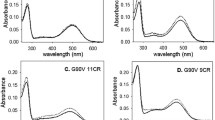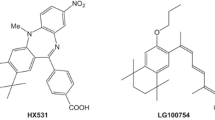Abstract
Retinal S-antigen and interphotoreceptor retinoid-binding protein-3 play a significant role in the etiopathogenesis of Eales' disease. Protein 3D structures are functionally very important and play a significant role in progression of the disease, hence these 3D structures are better target for further drug designing and relative studies. We developed 3D model structure of retinol-binding protein-3 and retinal S-antigen protein of human involved in Eales' disease. Functional site prediction is a very important and related step; hence, in the current course of analysis, we predicted putative functional site residues in the target proteins. Molecular models of these proteins of Eales' disease as documented in this study may provide a valuable aid for designing an inhibitor or better ligand against Eales' disease and could play a significant role in drug design.



Similar content being viewed by others
References
Sen A, Paine SK, Chowdhury IH, Mukherjee A, Choudhury S, Mandal LK, Bhattacharya B. Assessment of gelatinase and tumor necrosis factor-a level in the vitreous and serum of patients with Eales disease: Role of Inflammation-Mediated Angiogenesis in the Pathogenesis of Eales Disease .Retina. 2011. doi: 10.1097/IAE.0b013e318203c199.
Saxena S, Kumar D, Singh VK, Rajasingh J. Immunological studies in Eales disease: a review. Afro-Asian J Ophthalmol. 1995;13:19–22.
Therese KL, Deepa P, Therese J, Bagyalakshmi R, Biswas J, Madhavan HN. Association of mycobacteria with Eales’ disease. Indian J Med Res. 2007;126:56–62.
Narayanasamy A, Radhakrishnan S, Rishi P, Jyotirmoy B, Shah J, Joyce T. Ratio of the vitreous vascular endothelial growth factor and pigment epithelial-derived factor in Eales disease. J Ocular Biol Dis Informat. 2009;2:20–8.
Das T, Biswas J, Kumar A, et al. Eales’ disease. Indian J Ophthalmol. 1994;42:3–18.
Das T, Pathengay A, Hussain N, Biswas J. Eales’ disease: diagnosis and management. Eye. 2010;24:472–82.
Saxena S, Pant AB, Khanna VK, Singh K, Shukla RK, Meyer CH, et al. Tumor necrosis factor-a-mediated severity of idiopathic retinal periphlebitis in young adults (Eales’ disease): implication for anti-TNF-a therapy. J Ocular Biol Dis Informat. 2010;3:35–8.
Pfister C, Chabre M, Plouet J, Tuyen VV, De Kozak Y, Faure JP, et al. Retinal S antigen identified as the 48 K protein regulating light-dependent phosphodiesterase in rods. Science. 1985;228:891–3.
Saxena S, Rajasingh J, Biswas S, Kumar D, Shinohara T, Singh VK. Cellular immune response to retinal S-antigen and interphotoreceptor retinoid-binding protein fragments in Eales' disease patients. Pathobiology. 1999;67:39–44.
Pathan S, Chintan C, Sriram S. Intrinsically unstructured proteins: potential targets for drug discovery. Am J Infect Dis. 2009;5:133–41.
Gasteiger E, Hoogland C, Gattiker A, Duvaud S, Wilkins MR, Appel RD, Bairoch A. Protein identification and analysis tools on the ExPASy Server; John M. Walker, editors: The Proteomics Protocols Handbook, Humana. 2005. p. 571–607.
Arnold K, Bordoli L, Kopp J, Schwede T. The SWISS-MODEL Workspace: a web-based environment for protein structure homology modelling. Bioinformatics. 2006;22:195–201.
Kiefer F, Arnold K, Künzli M, Bordoli L, Schwede T. The SWISS-MODEL repository and associated resources. Nucleic Acids Res. 2009;37:387–92.
Peitsch MC. Protein modeling by e-mail bio/technology. Nature. 1995;13:658–60.
Thomas DG, Conrad CH, Thomas EF. Software extensions to UCSF Chimera for interactive visualization of large molecular assemblies. Structure. 2005;13:473–82.
Bowie JU, Lüthy R, Eisenberg D. A method to identify protein sequences that fold into a known three-dimensional structure. Science. 1991;253:164–70.
Lüthy R, Bowie JU, Eisenberg D. Assessment of protein models with three-dimensional profiles. Nature. 1992;356:83–5.
Benkert P, Künzli M, Schwede T. QMEAN server for protein model quality estimation. Nucleic Acids Res. 2009;37:510–4.
Laskowski RA, Watson JD, Thornton JM. ProFunc: a server for predicting protein function from 3D structure. Nucleic Acids Res. 2005;33:89–93.
Alasdair TR, Richard M. Q-Site Finder: an energy-based method for the prediction of protein–ligand binding sites. Bioinformatics. 2005;21:1908–16.
Srivastava P, Tiwari A, Trivedi AC. Computational prediction of 3D structure for the matrix protein 2 (BM2) of the influenza B virus. Intl Med Technol Univ Med J. 2010;1:22–36.
Acknowledgments
We wish to express our acknowledgement to Mr. Aseem Chauhan, Additional President, RBEF parent organization of Amity University Uttar Pradesh (AUUP) and chairman of Amity University Lucknow Campus; Maj. Gen. K.K Ohri, AVSM (Retd.), Director General of AUUP- Lucknow Campus, Asst. Professor Dr. Rajesh K. Tiwari, Deputy Director and Head, Amity Institute of Biotechnology, Lucknow and Professor Shally Awasthi, Dept. of Pediatrics, CSM Medical university, Lucknow, UP for providing their valuable support and encouragement throughout the work.
Author information
Authors and Affiliations
Corresponding author
Rights and permissions
About this article
Cite this article
Tiwari, A., Trivedi, A.C., Srivastava, P. et al. Comparative modeling of retinol-binding protein-3 and retinal S-antigen in Eales’ disease and prediction of their binding sites using computational methods. j ocul biol dis inform 3, 88–91 (2010). https://doi.org/10.1007/s12177-011-9060-z
Received:
Accepted:
Published:
Issue Date:
DOI: https://doi.org/10.1007/s12177-011-9060-z




